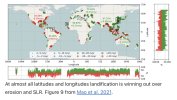Did you set your alarm for 3:12am to utter a response to Fudd? You two are the biggest losers ever. You're also morons and one is dumb and the other one is dumber. I have never witnessed such humiliation without humility. Pride before the fall!!! All you got is Gretta and the Climate Hoax. Total losers!!!A realist.
You are using an out of date browser. It may not display this or other websites correctly.
You should upgrade or use an alternative browser.
You should upgrade or use an alternative browser.
Climate and Weather
- Thread starter espola
- Start date
What up Dumb? I honestly hope you and Dumber had a wonderful Merry Christmas. Let's make 2024 the best year ever, cheers!!!
Home
flatearth101.com
Multi Sport
DA
The coldest temperature ever for an NFL Football game will be this weekend..
kickingandscreaming
PREMIER
The Honest Broker - Roger Pielke Jr
Landification: Even with sea level rise, around the world coastal land area has increased
One consequence of Japan’s magnitude 7.6 Noto Peninsula earthquake of January 4, 2024 was a significant uplift of the coast — in some places creating more than 200 meters of new shoreline. Geologist Judith Hubbard of Cornell University Xed/Tweeted that the earthquake resulted in “landification,” or the emergence of new land area.
That got me thinking: What are long-term trends in global landification?
If sea level rise is ongoing and inexorable, then all else equal, the areal extent of global land areas should be shrinking, especially in low-lying continental areas and among tropical islands. Indeed that is the message that NASA is telling children, warning of the disappearance of large parts of the coastline, as shown below, with large parts of Florida and Louisiana succumbing to the seas.¹
Sea levels around the world of course are rising and expected to continue to rise throughout the 21st century and beyond. However, from 1985 to 2015 — a period when global sea levels increased by about 60 millimeters (about 2.4 inches) — the areal extent of global coastal land increased by almost 34,000 square kilometers (about 13k square miles), or about the size of Belgium home to more than 11 million people.
If the notion of landification seems paradoxical or contrary to what you’ve read in the media, don’t worry, you won’t be not alone. I thought that also.
A team of Dutch researchers, Donchyts et al. 2016, warned that popular anecdotes can present a misleading picture of global trends in changes in the earth’s surface from land to water and vice versa. They write:
Climate reductionism once again seems to get in the way of a more nuanced and comprehensive understanding of global processes and dynamics. Let’s take a quick look at some relevant recent literature.
The literature on landification is in strong consensus that global land areas, even along coasts, are generally increasing in areal extent. For example, Mao et al. 2021 looked at global shorelines and found that instead of retreating on a global scale they are generally expanding:

One of the biggest factors leading to negative landification⁴ is the damming of rivers, which restricts the flow of sediment to river mouths, which allows erosion to predominate over accretion. For instance, Anthony et al. 2015 found that dams on the Mekong River have contributed to downstream erosion and the subsequent loss of land area:
The role of restricted sediment supply in the reduction of downstream land area in river deltas is reinforced globally by Nienhuis et al. 2020:
What about fears of disappearing islands in the South Pacific? As is often the case when one consults the peer-reviewed literature, there can be a large gap between narratives promoted in the media and real-world evidence.
“Despite concerns of erosion driven by sea level rise, no published evidence exists of pervasive erosion of atoll islands at a global scale” Holdaway et al. 2021
For example, Holdaway et al. 2021 find:
Landification: Even with sea level rise, around the world coastal land area has increased
One consequence of Japan’s magnitude 7.6 Noto Peninsula earthquake of January 4, 2024 was a significant uplift of the coast — in some places creating more than 200 meters of new shoreline. Geologist Judith Hubbard of Cornell University Xed/Tweeted that the earthquake resulted in “landification,” or the emergence of new land area.
That got me thinking: What are long-term trends in global landification?
If sea level rise is ongoing and inexorable, then all else equal, the areal extent of global land areas should be shrinking, especially in low-lying continental areas and among tropical islands. Indeed that is the message that NASA is telling children, warning of the disappearance of large parts of the coastline, as shown below, with large parts of Florida and Louisiana succumbing to the seas.¹
Sea levels around the world of course are rising and expected to continue to rise throughout the 21st century and beyond. However, from 1985 to 2015 — a period when global sea levels increased by about 60 millimeters (about 2.4 inches) — the areal extent of global coastal land increased by almost 34,000 square kilometers (about 13k square miles), or about the size of Belgium home to more than 11 million people.
If the notion of landification seems paradoxical or contrary to what you’ve read in the media, don’t worry, you won’t be not alone. I thought that also.
A team of Dutch researchers, Donchyts et al. 2016, warned that popular anecdotes can present a misleading picture of global trends in changes in the earth’s surface from land to water and vice versa. They write:
It turns out — as is so often the case on issues related to climate change — landification is influenced by many factors beyond just sea level rise. Many of these factors result from human activities other than those that influence climate change, especially the intentional or unintentional influence of human activities on land areas that might be far inland or in coastal regions.²{G]eneral conclusions cannot be drawn from a limited sample of case studies. Instead, planetary-scale monitoring is needed to understand (and disentangle) the causes of detected changes and their attribution to natural variability, climate change or man-made change.
Climate reductionism once again seems to get in the way of a more nuanced and comprehensive understanding of global processes and dynamics. Let’s take a quick look at some relevant recent literature.
The literature on landification is in strong consensus that global land areas, even along coasts, are generally increasing in areal extent. For example, Mao et al. 2021 looked at global shorelines and found that instead of retreating on a global scale they are generally expanding:

In another study, Nienhuis et al. 2020 find a “net land gain” in river deltas around the world:³At almost all latitudes and longitudes landification is winning out over erosion and SLR. Figure 9 from Mao et al. 2021.
In general, we found that accretion is the dominant trend over erosion across the world, suggested by the percentage of accretion/erosion along each latitude and longitude as well as the statistics for each continent (Fig. 9). The globally averaged shoreline change rate is about 0.26 m/yr, which is slightly larger than zero and suggests the global coastline is prograding. . . all continents except North America have coastlines that are, on average, accreting and have larger percentage of accretion than erosion.
Over the past 30 years, despite sea-level rise, deltas globally have experienced a net land gain of 54 ± 12 square kilometres per year (2 standard deviations), with the largest 1 per cent of deltas being responsible for 30 per cent of all net land area gains. Humans are a considerable driver of these net land gains—25 per cent of delta growth can be attributed to deforestation-induced increases in fluvial sediment supply.
One of the biggest factors leading to negative landification⁴ is the damming of rivers, which restricts the flow of sediment to river mouths, which allows erosion to predominate over accretion. For instance, Anthony et al. 2015 found that dams on the Mekong River have contributed to downstream erosion and the subsequent loss of land area:
Large deltas such as that of the Mekong are complex features the shoreline positions of which can change under the influence of a large range of factors, notably sediment supply, routing and storage, subsidence, sea level and waves and currents. We argue here that a decreasing sediment supply is the main factor underpinning the erosion that now affects more than 300 km of the Mekong delta shoreline.
The role of restricted sediment supply in the reduction of downstream land area in river deltas is reinforced globally by Nienhuis et al. 2020:
[F]or nearly 1,000 deltas, river damming has resulted in a severe (more than 50 per cent) reduction in anthropogenic sediment flux, forcing a collective loss of 12 ± 3.5 square kilometres per year (2 standard deviations) of deltaic land. Not all deltas lose land in response to river damming: deltas transitioning towards tide dominance are currently gaining land, probably through channel infilling.
What about fears of disappearing islands in the South Pacific? As is often the case when one consults the peer-reviewed literature, there can be a large gap between narratives promoted in the media and real-world evidence.
“Despite concerns of erosion driven by sea level rise, no published evidence exists of pervasive erosion of atoll islands at a global scale” Holdaway et al. 2021
For example, Holdaway et al. 2021 find:
The study also removed from its analysis the engineered islands of the South China Sea, and still found evidence of atoll stability:Despite concerns of erosion driven by sea level rise, no published evidence exists of pervasive erosion of atoll islands at a global scale. . . Using rich collections of Landsat imagery, this study analyses changes in land area on 221 atolls in the Indian and Pacific Oceans. Results show that, between 2000 and 2017, the total land area on these atolls has increased by 61.74 km2 (6.1 %) from 1007.60 km2 to 1069.35 km2. Most of the change in land area resulted from island building within the Maldives and on atolls in the South China Sea. Since 2000, the Maldives have added 37.50 km2 of land area, while 16.57 km2 of new islands have appeared within the South China Seas Spratly and Paracel chains.
<cont>When we excluded the atolls in the South China Sea and considered all other atolls in the Pacific Ocean, we saw a 6.00 km2 increase, with a per atoll average increase of just 0.04 km2 with a median value of 0.01 km2. Our results showed that, aside from atolls that are heavily engineered, the land area on most atolls has been stable with no evidence of loss over the study period. This observation is consistent with recent studies that have also shown a predominantly stable or accretionary trend in the area of atoll islands worldwide (McLean and Kench, 2015; Duvat, 2019).
kickingandscreaming
PREMIER
<p2>The Honest Broker - Roger Pielke Jr
Landification: Even with sea level rise, around the world coastal land area has increased
One consequence of Japan’s magnitude 7.6 Noto Peninsula earthquake of January 4, 2024 was a significant uplift of the coast — in some places creating more than 200 meters of new shoreline. Geologist Judith Hubbard of Cornell University Xed/Tweeted that the earthquake resulted in “landification,” or the emergence of new land area.
That got me thinking: What are long-term trends in global landification?
If sea level rise is ongoing and inexorable, then all else equal, the areal extent of global land areas should be shrinking, especially in low-lying continental areas and among tropical islands. Indeed that is the message that NASA is telling children, warning of the disappearance of large parts of the coastline, as shown below, with large parts of Florida and Louisiana succumbing to the seas.¹
Sea levels around the world of course are rising and expected to continue to rise throughout the 21st century and beyond. However, from 1985 to 2015 — a period when global sea levels increased by about 60 millimeters (about 2.4 inches) — the areal extent of global coastal land increased by almost 34,000 square kilometers (about 13k square miles), or about the size of Belgium home to more than 11 million people.
If the notion of landification seems paradoxical or contrary to what you’ve read in the media, don’t worry, you won’t be not alone. I thought that also.
A team of Dutch researchers, Donchyts et al. 2016, warned that popular anecdotes can present a misleading picture of global trends in changes in the earth’s surface from land to water and vice versa. They write:
It turns out — as is so often the case on issues related to climate change — landification is influenced by many factors beyond just sea level rise. Many of these factors result from human activities other than those that influence climate change, especially the intentional or unintentional influence of human activities on land areas that might be far inland or in coastal regions.²
Climate reductionism once again seems to get in the way of a more nuanced and comprehensive understanding of global processes and dynamics. Let’s take a quick look at some relevant recent literature.
The literature on landification is in strong consensus that global land areas, even along coasts, are generally increasing in areal extent. For example, Mao et al. 2021 looked at global shorelines and found that instead of retreating on a global scale they are generally expanding:
View attachment 19360
In another study, Nienhuis et al. 2020 find a “net land gain” in river deltas around the world:³
One of the biggest factors leading to negative landification⁴ is the damming of rivers, which restricts the flow of sediment to river mouths, which allows erosion to predominate over accretion. For instance, Anthony et al. 2015 found that dams on the Mekong River have contributed to downstream erosion and the subsequent loss of land area:
The role of restricted sediment supply in the reduction of downstream land area in river deltas is reinforced globally by Nienhuis et al. 2020:
What about fears of disappearing islands in the South Pacific? As is often the case when one consults the peer-reviewed literature, there can be a large gap between narratives promoted in the media and real-world evidence.
“Despite concerns of erosion driven by sea level rise, no published evidence exists of pervasive erosion of atoll islands at a global scale” Holdaway et al. 2021
For example, Holdaway et al. 2021 find:
The study also removed from its analysis the engineered islands of the South China Sea, and still found evidence of atoll stability:
<cont>
Sea level rise is important to coastal management. Of this, there is no doubt — it will continue, regardless of what changes are made to energy policies.⁵ Sea level rise will cause impacts around the world and require adaptation regardless what is done on global energy policies.
At the same time, the consequences of sea level rise for coasts around the world is not as simple as rising seas inexorably encroaching upon static land. Human influences such as sedimentation and reclamation make a big difference on outcomes. So too do natural processes of erosion and deposition. And there are other factors as well — for instance 2015 study argues that the Earth is expanding a little bit each year, to some degree offsetting the effects of sea level rise.⁶
Emphasizing sea level rise in the absence of these various other significant factors commits the same error that we have identified when future climate impacts are projected in the absence of adaptation to climate. Considering the effects of a single variable while ignoring other results is a sensitivity analysis, not a meaningful projection of the future.
Managing coastlines around the world will be a big challenge in the 21st century. It is also one that we are well prepared for.
kickingandscreaming
PREMIER
1. At the rate suggested by NASA here, 20 feet of sea level rise would occur in 3,429 years. In contrast, the IPCC AR6 projects a median sea level rise in 2100 of less than 2 feet for a RCP4.5 scenario.<p2>
Sea level rise is important to coastal management. Of this, there is no doubt — it will continue, regardless of what changes are made to energy policies.⁵ Sea level rise will cause impacts around the world and require adaptation regardless what is done on global energy policies.
At the same time, the consequences of sea level rise for coasts around the world is not as simple as rising seas inexorably encroaching upon static land. Human influences such as sedimentation and reclamation make a big difference on outcomes. So too do natural processes of erosion and deposition. And there are other factors as well — for instance 2015 study argues that the Earth is expanding a little bit each year, to some degree offsetting the effects of sea level rise.⁶
Emphasizing sea level rise in the absence of these various other significant factors commits the same error that we have identified when future climate impacts are projected in the absence of adaptation to climate. Considering the effects of a single variable while ignoring other results is a sensitivity analysis, not a meaningful projection of the future.
Managing coastlines around the world will be a big challenge in the 21st century. It is also one that we are well prepared for.
2. I don’t discuss rivers and lakes here, but land-water interactions and landification processes are important there as well.
3. See also the subsequent exchange on their methods here and here.
4. Maybe delandification?
5. Of course as well, less human-forced climate change means less ultimate sea level rise. But even so, energy policy will not be a control knob which we can use to fine tune sea levels in coming decades or indeed much of this century.
6. In researching this post, this was the first time I had heard this claim.
Multi Sport
DA
"Coldest Iowa caucuses day on record
Temperatures are expected to be at or below zero in Iowa on Monday."
https://abcnews.go.com/US/video/col...#:~:text=Coldest Iowa caucuses,Iowa on Monday.
Temperatures are expected to be at or below zero in Iowa on Monday."
https://abcnews.go.com/US/video/col...#:~:text=Coldest Iowa caucuses,Iowa on Monday.
"Coldest Iowa caucuses day on record
Temperatures are expected to be at or below zero in Iowa on Monday."
https://abcnews.go.com/US/video/coldest-iowa-caucuses-day-record-106381745#:~:text=Coldest Iowa caucuses,Iowa on Monday.
WHO started this thread? The loser liar should come back here and defend his lies at least. I hear dude is now selling Vegan Snake oil 




Al "Espola" Gore Tells CNN About What the World Needs to Do to Stop Climate Change. These fools actually think they can stop the climate from changing. Global warming my ass! I know 100% they can mess with the climate but you ain't going to change it.

Highest recorded temperature for a year, "year" defined either way.
"Coldest Iowa caucuses day on record
Temperatures are expected to be at or below zero in Iowa on Monday."
https://abcnews.go.com/US/video/coldest-iowa-caucuses-day-record-106381745#:~:text=Coldest Iowa caucuses,Iowa on Monday.
Highest recorded temperature for a year, "year" defined either way.
Damn... you were replying to yourself here, too. Don't you pay attention to what account you're logged into before hitting "post reply"?










